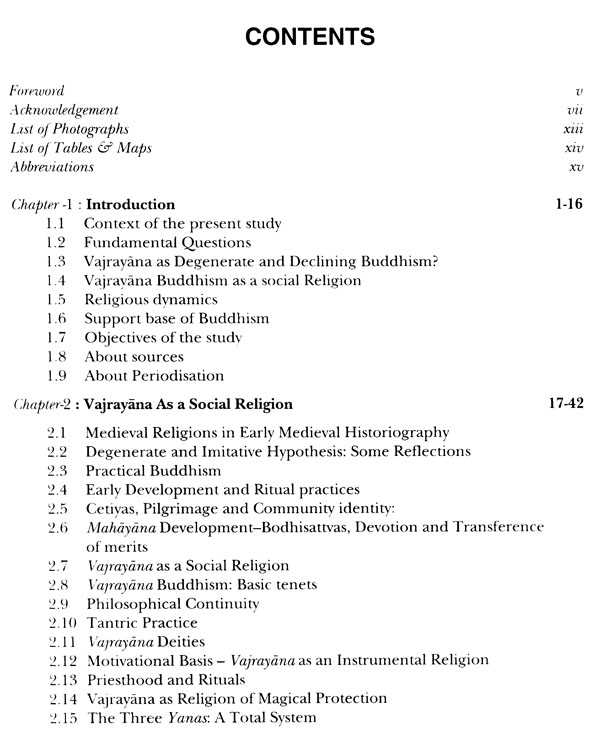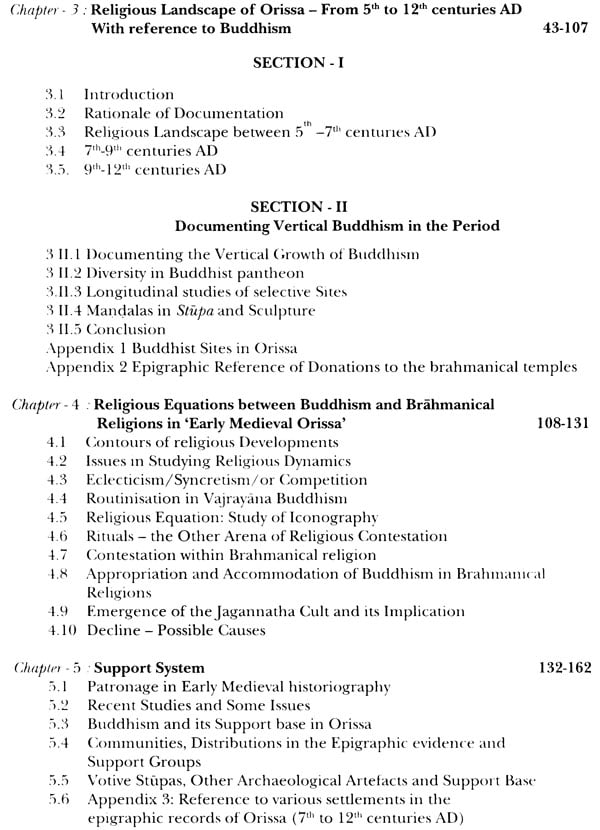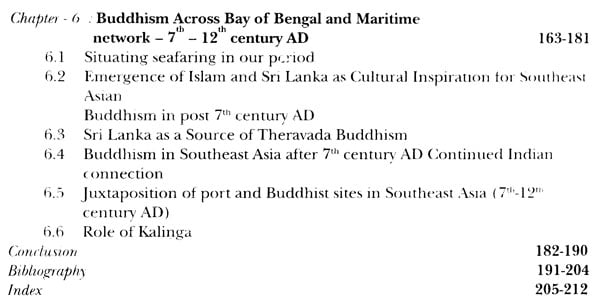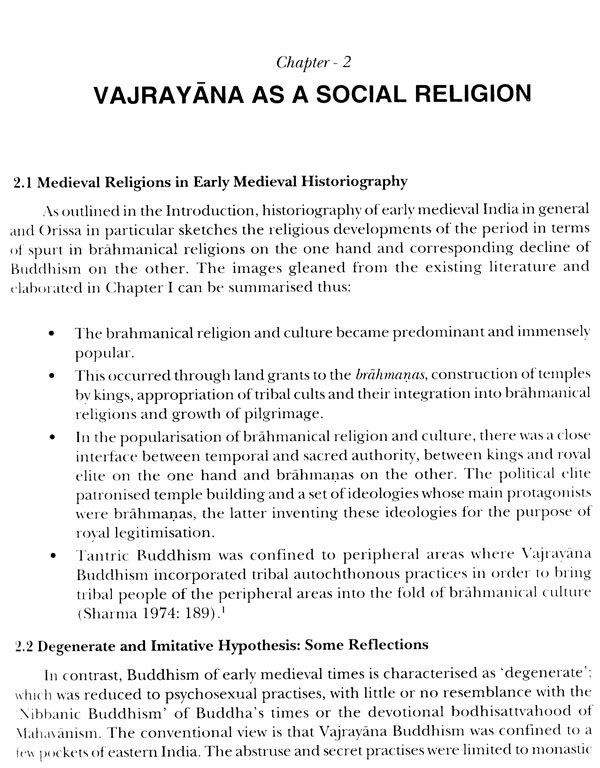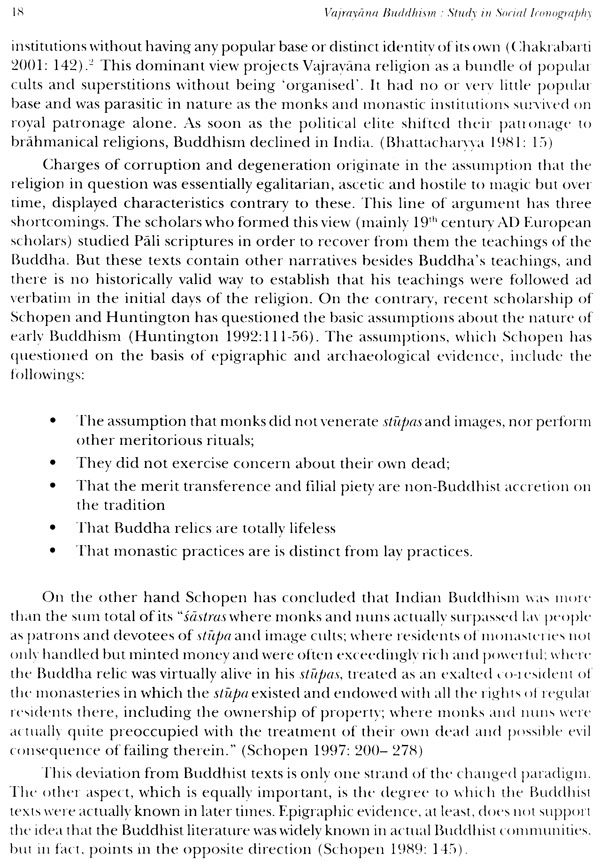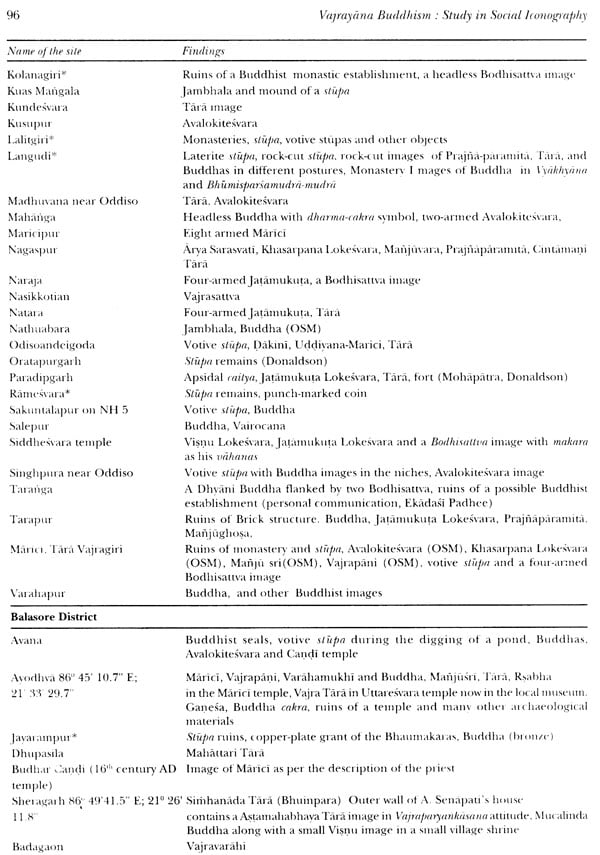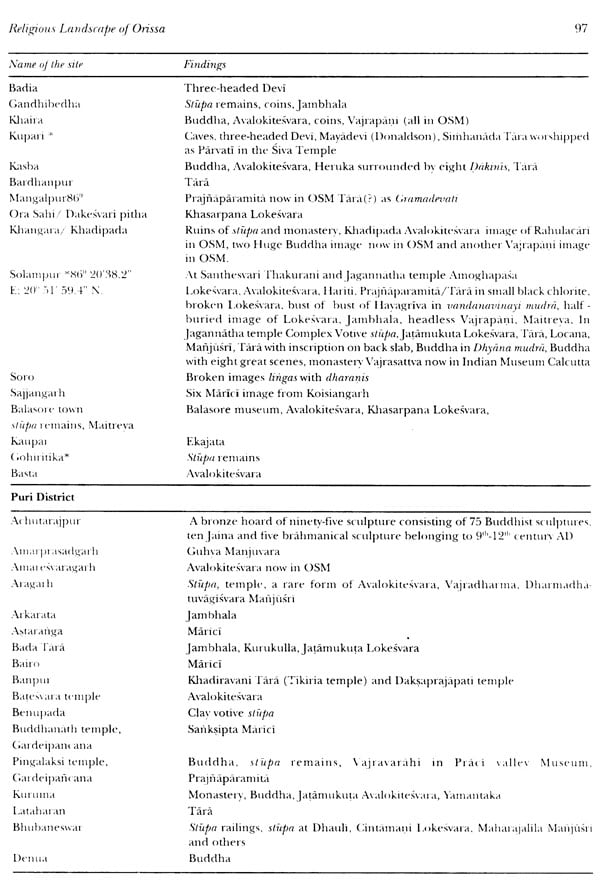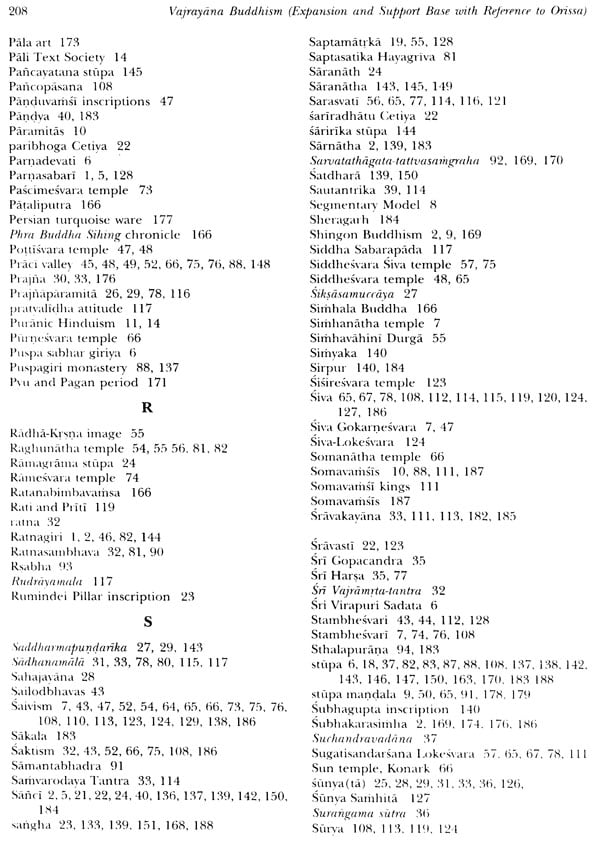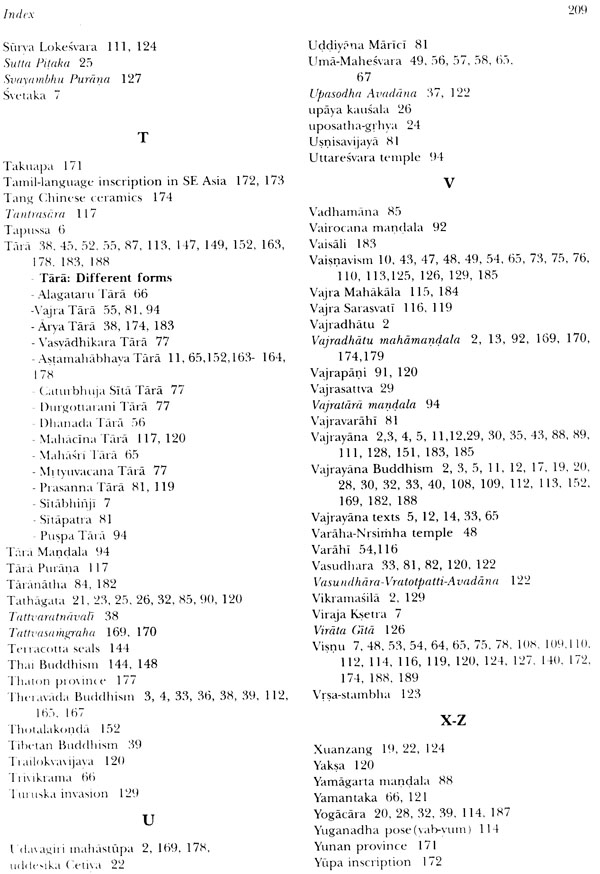
Vajrayana Buddhism - Study in Social Iconography
Book Specification
| Item Code: | NAY676 |
| Author: | Umakant Mishra |
| Publisher: | Pratibha Prakashan |
| Language: | English |
| Edition: | 2009 |
| ISBN: | 9788177022018 |
| Pages: | 222 (Throughout B/w Illustrations) |
| Cover: | HARDCOVER |
| Other Details | 11.50 X 9.00 inch |
| Weight | 1.02 kg |
Book Description
The book makes copious documentation of religious sites from archaeological and epigraphic sources to argue that poly- religiosity defines the religious landscape of early medieval Orissa, and then, it goes on to explain the relations between brahmanical religions and Buddhism. In the process, it analyses the support base of Buddhism, nature of monastic complex and various markers of support base. The book also explores the continued Indian connection in Southeast Asian Buddhism after 7th century AD.
At present, he is working for American India Foundation in computer-aided learning in government schools of Orissa.
The interest of most scholars focused on the art and architecture of the major archaeological sites in the Asia hills, on the relations of Buddhism to political power in the Bhauma-Kara period and on tantric Buddhism as an intellectual and ritual phenomenon to which Orissa appears to have made important contributions.
The present book looks at Buddhism from a different angle. What were the social and religious needs in early medieval society of Orissa, needs to which Buddhism could give adequate answers? How did religious practice change in response to changing socio-political settings and economic expectations? In the multireligious environment of Orissa, where Buddhism, Vishnuism, Shaivism, Shaktism and tribal religions all tried to address the social and spiritual needs of the population, how did these religious groups interact and relate to each other?
Umakanta Mishra addresses such questions and adduces also a wealth of material on the changing face of Buddhism at a time when tantric influences from Assam and Kashmir penetrated Buddhism as well as other religious groups. The author states that Buddhism did not only survive in early medieval Orissa, it prospered and expanded its influence from the 5th century onwards and reached the peak of its cultural influence in the T" to 12th centuries. Thereafter, for little known reasons, Buddhism declined rapidly to a degree that came near total extinction. What had caused such abrupt decline in the early 13th century?
The author is aware that this sudden change in the fortunes of Buddhism in Orissa calls for an explanation. He notices that when the Gangas replaced the . Somavamsis as rulers of Orissa, the state religion began to be focused entirely on the cult of Purushottamajagannatha and on the Vaishnava tradition, with Narasimha as its most victorious representative. But he also knows that the rise of'jagannatha as a tutelary deity of the Ganga kings - and, indeed, officially claimed divine ruler of the country - cannot be the only reason, because this change affected all other religions in equal manner. Obviously, the royal predilection for the cult of jagannatha did not lead to any noticeable decline of Shaivism or Shaktism in Orissa. Obviously, the reason must be sought elsewhere. Militant action or social oppression against the Buddhists is not on record.
One should rather look for reasons leading to the decline of Buddhism in Orissa in areas beyond the frontiers of the state. The Buddhist networks in Orissa had been linked with those of Chhattisgarh, i.e., the upper regions of the Mahanadi river where a large number of flourishing Buddhist viharas existed, and with the famous Buddhist intellectual centers in Bihar and Bengal, particularly with Nalanda and, to a lesser degree, also with Vikramasila, both acting as intellectual counterparts that exerted a continuous influence on the tantra-oriented Buddhist elite of Orissa. But when, in the first decade of the 13th century, Afghan armies overran the Gangetic plain and raided these ancient and renowned seats of traditional learning together with their famous libraries, this turned out to be a decisive blow for Buddhism in Orissa as well.
While Hindu Brahmins used to have their sacred scriptures at home, the Buddhists kept their written tradition preferably in well-kept libraries attached to important monasteries. The destruction of these libraries by Muslim raids have dealt a serious blow to Buddhism in northern India and led to an exodus of Buddhists from the Ganges valley to South-East Asia. It also affected Buddhism in Orissa.
In view of the deeply rooted religious tolerance in Orissan tradition, the exodus of Buddhists from Orissa should probably not be sought in social pressure or political interference by the rulers of the state, but rather in new and highly promising opportunities offered across the sea in Southeast Asia where Buddhism was about to become the dominant culture. Enormous stupas were erected; Buddhist art reached a second peak in its glorious history. In order to infuse religious life into these monuments, to bring a high standard of Buddhist teaching to newly established viharas and to animate the intellectual discourse at royal courts in Southeast Asia, entire shiploads of Buddhist priests and scholars were needed in the countries across the bay of Bengal. The result was a New-world exodus, impelled less by difficulties at home but rather by splendid opportunities across the sea where the Southeast Asian countries from Myanmar to Java initiated an unparalleled upsurge of Buddhist art and life-style.
Umakant Mishra is to be congratulated for having given detailed information about the social background and religious practice of Mahayana and Vajrayana Buddhism in rural Orissa, and about the mixed culture that emerged when Shaiva, Shakta and Bauddha traditions were all affected by a strong undercurrent of tantric elements. It was this type of intellectual absorption of a variety of socio-religious trends that must have been transferred from Orissa (and other states of Eastern India) to the Buddhist communities in Southeast Asia.
Recent archaeological excavations and explorations have brought to light more than 150 Buddhist sites in Orissa. Most of these sites flourished between 7th to 12th centuries AD, even though the nucleus of some of these sites, like that of Ratnagiri, Langudi and Lalitgiri, go back to pre - and early centuries of the Christian era. Some of these Buddhist establishments were not only spatially vast but also showed remarkable temporal continuity of more than a millennium. From the structural point of view, the monastic complexes were huge, comparable to the Kalinga style temples, which were constructed in the same period.' Historical evidence indicates horizontal expansion of Buddhist sites, enlargement of few establishments and uninterrupted temporal continuity of some others in the period between 5th century but especially between T" century and 12th century AD.
This expansion of Buddhism was not spatial alone. Buddhism of this period introduced a large pantheon structure, experimented with new forms of iconography and innovated new rituals and practices. Buddhism of the period, especially the Vajrayana form, introduced a number of Buddhas, Bodhisattvas, gods and goddesses.
People worshipped these gods and goddesses for fulfilling many of their everyday needs. Each god and goddess was assigned important instrumental roles. For instance, Parnasabari was invoked for curing epidemics; Cintamani Avalokitesvara, for bestowing wealth, etc. Buddhist sites of Orissa have yielded images of many of these deities. The worship of such gods and goddesses was not limited to monks alone.
Their worship by the lay worshippers in Orissa was attested by number of votive stupas at the Buddhist sites of Orissa, which carry in their niches these gods and goddesses, indicating the cult preference of pilgrims.
The worship of these deities also involved elaborate rituals." Archaeological evidence shows increasing use of dhara and mandalaui the realm of ritual practices.
The mandala form of worship was highly complex and elaborate, which required a ritual specialists. The Vajrayana texts of the period, like the Hevajra Tantra, the Guhsasamaja-tantra, etc. refer to the role of sexual partner for monks. This would have resulted in the emergence of a hereditary priest/monk, required in the complex mandala rituals of the households, Archaeological finds include secret cellar within the monastic complex indicating some secret esoteric ritual practices, which were integral to the Vajrayana form of Buddhism. But iconographic evidence also indicates that there was a conscious attempt to suppress possible objectionable features of Vajrayana Buddhism, like the trampling of the Hindu deities and embracing deities.
The relative absence of embracing Buddhist deities as well as those of Buddhist deities trampling on brahmanical divinities indicate a conscious attempt to restrict the extreme elements of the religion.
Thus, archaeological evidence from these Buddhist sites indicates great expansion, uninterrupted continuity and attempt to making Buddhism more instrumental to address the everyday need of the laity.
This expansion of Buddhism was not restricted to Orissa alone. In eastern India, there was an enormous growth of Buddhism with new monasteries like Ratnagiri and Vikramasila coming up and old establishment like Nalanda and Bodh Gaya continuing. In other parts of the subcontinent, Buddhist establishments of the earlier period, like Sarnatha, Suffice, Kanheri continued to exist even though many sites of Madhyadesa and Buddhist cave sites of western Deccan, southern Kalinga (Thotalakonda) and the Krishna valley declined. However, new establishments like Negapattinam in Tamilnadu also came up during this period.
The innovations that Vajrayana made in terms of the mandala theme in Buddhist architecture and sculpture, as reflected in the Udayagiri stupa and numerous mandala sculptures of Orissa in the postfix'" century, went to Southeast Asia and further east to China, Korea and Japan and across the Himalayas to Nepal and Tibet. It is to be noted that two important Buddhist monuments of Central Java, notably Borobudur and Candia Mendut were mandala-stupas built on the Vajradhatu and Mahakarundgarbhodbhaua mandala respectively (Lundquist 1997:283-306). Similarly, the Shingon Buddhism of Japan was largely molded on the mandala form. It is important to note that the Buddhist monks, namely Amoghavajra and Subhakarasirha, who took these two mandalas to China, were either from Orissa or associated with it (Yelling 1945: 251-255; Dagan 1978: 178).
Thus, contrary to the received wisdom about the decline of Buddhism in the period, the historical evidence indicates that Buddhism expanded in some regions, continued in others and saw enormous spread outside India during 7th century to 12th century.
Book's Contents and Sample Pages
